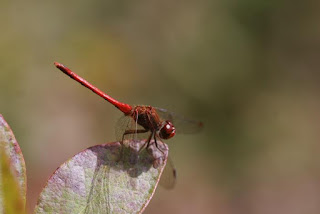An unseasonably warm spell lately has resulted in quite a few bugs that "should" have disappeared a few weeks ago - whether to hibernate or simply die from the colder weather depends on the species - still kicking around my local spots.
The Gray Hairstreak (Strymon melinus) above is one of the later flying butterflies normally, but this particular individual is showing some wear and if cold weather had occurred, may not have made it. However, he was flying around maniacally today as Hairstreaks tend to do.
In contrast, this Eastern-tailed Blue (Everes comyntas) from the same area is very fresh. This species is interesting as they have up to 3 broods a year, in contrast to most butterflies which have just one, or uncommonly, two.
From the same area, but last week, this Red-bellied Tiger Beetle (Cicindela rufiventris) was an adult that had survived long past when of his companions died off in late August. The larvae dig to below the frost line during the winter and emerge as adults the following summer.
Dragonflies and damselflies (like the male Ishnura hastata pictured) are often some of the last large insects flying in the year, certain species regularly flying into mid-late November.
This guy - a male Sympetrum vicinum - is usually the last dragonfly on the wing in the fall, hence the common name of "Autumn Meadowhawk". This particular individual has his abdomen up in the air and is probably regulating his temperature that way - either by orienting to expose the maximum surface area to heat, or to minimize surface area exposed to cool down. The adaptations, both behavioral and physical, to control body temperature in animals could fill many a book (look up: elephant ears or termite nest construction).
I found a few more cool beetles that will be detailed in a later post. Until then, get out and enjoy the warm weather. Find some butterflies!





No comments:
Post a Comment